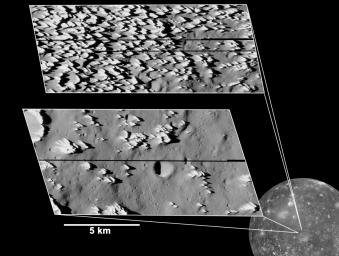
|
Callisto Close-up with Jagged Hills
- Click the image above for a larger view
- Full-Res JPEG (2000 x 1510) (311.7 kB)
- Full-Res TIFF (2000 x 1510) (1.6 MB)
Caption:
The highest-resolution views ever obtained of any of Jupiter's moons, taken by NASA's Galileo spacecraft in May 2001, reveal numerous bright, sharp knobs covering a portion of Jupiter's moon Callisto.
The knobby terrain seen throughout the top inset is unlike any seen before on Jupiter's moons. The spires are very icy but also contain some darker dust. As the ice erodes, the dark material apparently slides down and collects in low-lying areas. Over time, as the surface continues to erode, the icy knobs will likely disappear, producing a scene similar to the bottom inset. The number of impact craters in the bottom image indicates that erosion has essentially ceased in the dark plains shown in that image, allowing impact craters to persist and accumulate.
The knobs are about 80 to 100 meters (260 to 330 feet) tall, and they may consist of material thrown outward from a major impact billions of years ago. The areas captured in the images lie south of Callisto's large Asgard impact basin.
The smallest features discernible in the images are about 3 meters (10 feet) across.
Background Info:
The Jet Propulsion Laboratory, a division of the California Institute of Technology in Pasadena, manages the Galileo mission for NASA's Office of Space Science, Washington, D.C. Additional information about the spacecraft and its discoveries is available on the Galileo home page at http://solarsystem.nasa.gov/galileo/ .
Cataloging Keywords:
| Name | Value | Additional Values |
|---|---|---|
| Target | Callisto | |
| System | Jupiter | |
| Target Type | Satellite | |
| Mission | Galileo | |
| Instrument Host | Galileo Orbiter | |
| Host Type | Orbiter | |
| Instrument | Solid-State Imaging (SSI) | |
| Detector | ||
| Extra Keywords | Crater, Dust, Grayscale, Impact | |
| Acquisition Date | ||
| Release Date | 2001-08-22 | |
| Date in Caption | ||
| Image Credit | NASA/JPL/Arizona State University, Academic Research Lab | |
| Source | photojournal.jpl.nasa.gov/catalog/PIA03455 | |
| Identifier | PIA03455 | |
